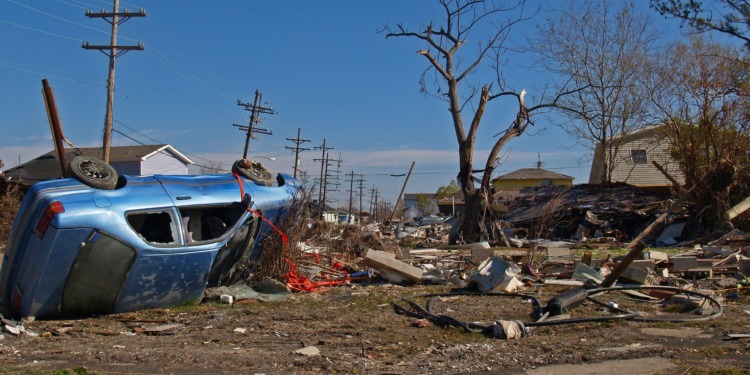Earthquakes, hurricanes, cyclones, tsunamis, and severe weather events have happened nearly everywhere, and seem to have increased in frequency. The direct costs in terms of response, clearance, and reconstruction, as well as the impact on economies, are enormous and are the subject of headlines, television, and other media, initially and somewhat lessening as time goes by. What gets less attention is mental health: the psychological impact on the people affected, and the rising tendency to suicide.
Some people are so traumatized they essentially give up hope and are deeply depressed, while others show the resiliency to move forward, picking up the pieces they can, and carving new lives when they cannot.
The point is that these “costs” are not usually seen as deserving of extra response from public authorities and resources. Typically, reliance is on relatives, communities, and religious groups to provide support, especially in the immediate aftermath.
The effects are both immediate but also long-term. We have seen in the most drastic instances where some people live through a horrific experience, and while immediate administrative matters may be all-absorbing initially, in the aftermath they lose hope, become deeply depressed and some choose to stop living.
An example of such a delayed response to trauma was Primo Levi, a brilliant writer and thinker, who wrote about his personal guilt in having survived Auschwitz and years later committed suicide, a long-delayed consequence of the death camp experience.
“Suicide is a premeditated act, not a spontaneous, instinctive act; it implies a deliberate choice… and for that…there was simply no time in a death camp. The victim’s mental space for any choice —especially a moral choice — was reduced to zero.”
— Musings on Mortality: from Tolstoy to Primo Levi, page 150. Victor Brombert, 2013.
The World Health Organization (WHO), provides a useful frame of reference:
“While the link between suicide and mental disorders (in particular, depression and alcohol use disorders) is well established in high-income countries, many suicides happen impulsively in moments of crisis with a breakdown in the ability to deal with life stresses, such as financial problems, relationship break-up or chronic pain and illness.”
Growing Suicide Numbers
There is no doubt that depression is a major catalyst: “An individual suffering with depression is twenty times more likely to die by suicide than someone without the disorder.3”
Television news has been extremely effective in showing natural disasters and their tragic impact in terms of loss of property, shelter, and livelihood.
Those who are not directly affected see the extent of damage and hear those who are describing their situation as likened to a war zone. Those of us who are not directly involved listen to interviews with the survivors and sympathize.
But over time, often short, our attention shifts to the next disaster or news story. The affected people are left to cope psychologically, some better able to do so than others. These people, their families, and communities are hugely affected, but not visibly to viewers as is the shocking physical destruction.
Looking at the Young and Suicides
While disasters affect people of all ages, the alarming numbers of young people committing suicide triggered by multiple causes, need special consideration.
What is known is that globally, suicide was the fourth leading cause of death among 15-29-year-olds in 2019.
And it is possible that those even younger are increasingly taking their own lives. Neither readily analyzed nor is there detailed data regarding the extent to which access and use of the internet and social media outlets play a part–directly or indirectly affecting suicide, especially among the young.
A documented case in England admittedly on the edges, but instructive of potential dangers, involved exchanges on the internet between two young men; the teenager begs his friend to kill him and is almost mortally wounded. This story made into a movie is one extreme example of how ready access to the internet can facilitate suicidal desires.
Ten years later from this story, access and impact of new technology in our evolving technological age is both fact and unpredictable.
The first known instance of AI leading to such dire result, a man apparently committed suicide after having been encouraged by a chatbot, frightening to be sure.
What Can Be Done
Suicide is a global phenomenon in all regions of the world. It is a serious public health problem but preventable with timely, evidence-based and often low-cost interventions.
We already know that “positive media” can make a big difference, with U.S. rapper Logic’s song, ‘1-800-273-8255’ which was found in 2021 to have probably helped to prevent hundreds of suicides.
But more is needed. For national responses to be effective, a comprehensive multisectoral suicide prevention strategy is needed.
A national strategy would include a range of prevention measures such as surveillance monitoring of potentially vulnerable individuals, raising public awareness, as well as training of health workers, educators, police, first responders, and public officials.
This means not only the health sector but education, employment, social welfare, those involved with governance, and others. For victims of natural disasters, people suffering losses through no fault of their own, such support should be an integral part of emergency response and recovery.
Further, we need better ways to look for warning signs in youth and take therapeutic action—before it’s too late.
Editor’s Note: The opinions expressed here by the authors are their own, not those of Impakter.com — In the Featured Photo: tornado destruction. Source: Image by Gabe Raggio from Pixabay









